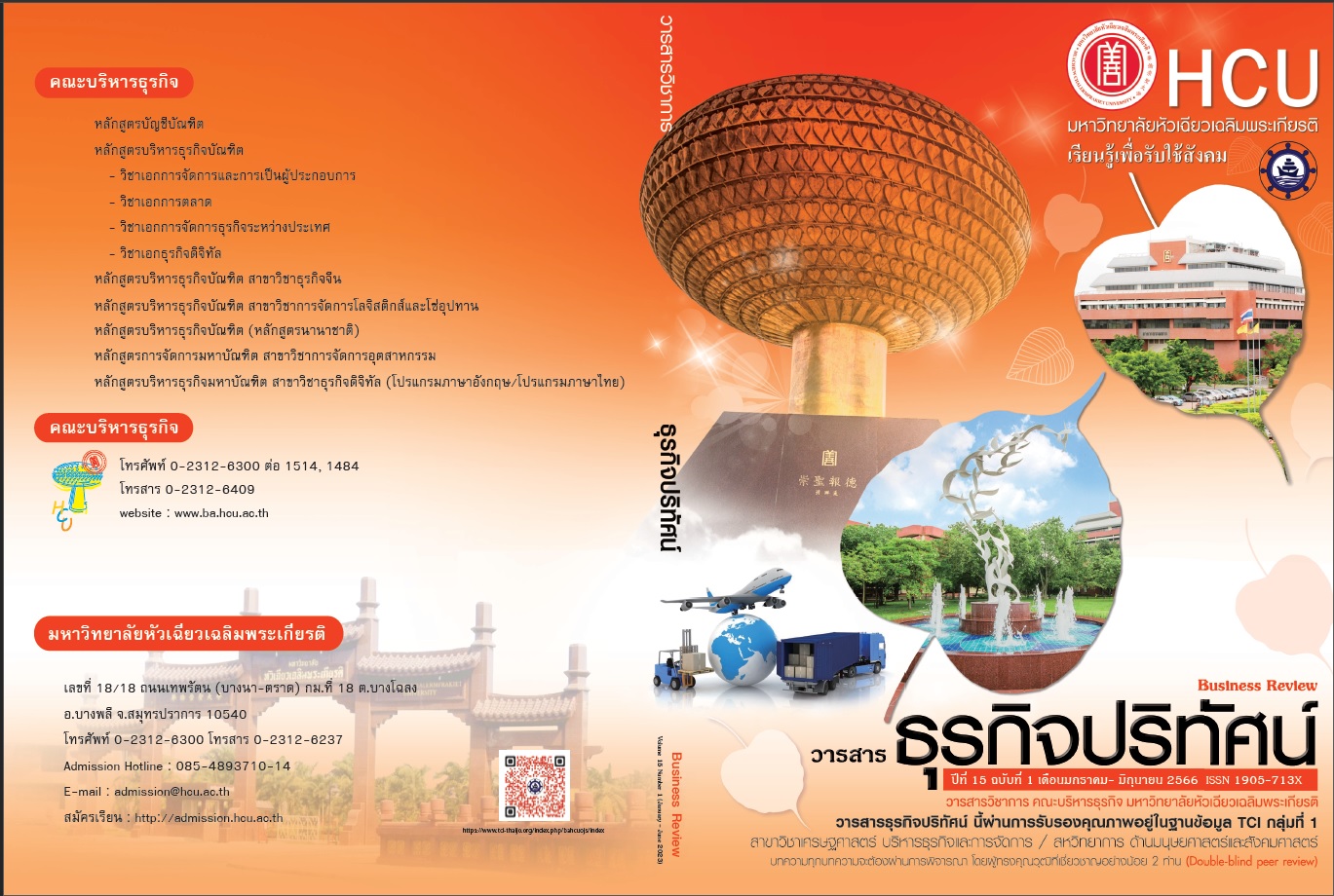Structural Equation Model of Chanthaburi Fruit Market’s Integrated Marketing Communication to Increase Business Capability with China as a Trading Partner
Keywords:
Structural equation model, Integrated marketing communication, Chanthaburi fruit market, China as a trading partnerAbstract
The objectives were to develop the structural equation model of Chanthaburi fruit market’s integrated marketing communication to increase business capability with china as a trading partner. This research was quantitative research. Data were collected by 285 GAP-certified farmers in Chanthaburi. The indices measure the Goodness of Fit evaluation criteria. The findings revealed that the research model was consistent with empirical data. The chi-square/df was 2.24, the RMSEA was 0.06, the GFI was 0.90, the CFI was 0.92, and the NFI was 0.90. Results show that 1) the fruit factor has a direct influence on integrated marketing communication. 2) the fruit factor has a direct influence on the increase of business capability, and an indirect influence with integrated marketing communication as a mediator variable. 3) the intercultural competence is found to have a direct influence on integrated marketing communication. 4) the intercultural competence has direct influence on the increase of business capability. Results show that an indirect influence through a mediator variable of integrated marketing communication to the increase of business capability. Finally, 5) the integrated marketing communication has a direct influence on the increase of business capability.
References
กรมการค้าภายใน. (7 ตุลาคม, 2564). ติดตามสถานการณ์ราคาผลไม้พื้นที่ภาคตะวันออก. ใน นายจุรินทร์ ลักษณวิศิษฏ์ (ประธาน), เตรียมการกำหนดมาตรการบริหารจัดการผลไม้ปี พ.ศ.2565 ภาคตะวันออก [Symposium]. การประชุมเตรียมการกำหนดมาตรการบริหารจัดการผลไม้ปี พ.ศ.2565 ภาคตะวันออก รองนายกรัฐมนตรีและรัฐมนตรีว่าการกระทรวงพาณิชย์ นายจุรินทร์ ลักษณวิศิษฏ์. จันทบุรี.
กรมวิชาการเกษตร. (2563). รายชื่อฐานข้อมูล GAP DOA Online ผลการดำเนินงาน ณ วันที่ 27 มิ.ย. 2563. กรมวิชาการเกษตร. https://gap.doa.go.th/?T=2&R=22.
กัลยา วานิชย์บัญชา. (2556). การวิเคราะห์ความถดถอยและสหสัมพันธ์เชิงซ้อน. โรงพิมพ์แห่งจุฬาลงกรณ์มหาวิทยาลัย.
พงศกร จันท์พิพัฒน์พงศ์. (2558). กลยุทธ์การสื่อสารการตลาดแบบบูรณาการเพื่อเข้าสู่ตลาดอาเซียนของผู้จำหน่ายในการตลาดแบบเครือข่าย. วารสารวิทยาลัยพาณิชยศาสตร์บูรพาปริทัศน์, 10(1), 1-14.
มนต์ชัย ลีลาถาวรสุข. (2561). ผลกระทบของข้อตกลงการค้าเสรีอาเซียน-จีนที่มีต่อการลงทุนระหว่างไทยกับจีน. วารสารเศรษฐศาสตร์และ กลยุทธ์การจัดการ (Journal of Economics and Management Strategy), 4(1), 81-96.
สำนักงานปลัดกระทรวงเกษตรและสหกรณ์. (2563). สถานการณ์ผลไม้ไทยในตลาดจีนปี พ.ศ.2563 และแนวโน้ม. ฝ่ายการเกษตร ประจำสถานกงสุลใหญ่ ณ นครกว่างโจว. https://www.opsmoac.go.th/guangzhou-dwl-files-431491791822.
Adler, N. J. (1997). International dimensions of organizational behavior (3 rd). Cincinnati: South-Western.
Ali, N. N., Shaban, O. S., & Al-Zubi, Z. (2017). The Effect of Implementing Integrated Marketing Communication Systems on Improving Marketing Function" A case study on OFFTEC Company". International Research Journal of Applied Finance, 8(4), 186-194.
Avraham, E., & Ketter, E. (2008). Media strategies for marketing places in crisis. Journal of Vacation Marketing, 14(4), 373.
Braddock, J. J. (2013). Achieving'effective'development: An examination of intercultural communication competence from the development practitioner's perspective. University of Florida.
Clouse, C. M. (2017). The role of place image in business location decisions (Order No. 10665936). [Doctoral dissertation, Graduate Council of Cleveland State University]. ProQuest Dissertations & Theses Global.
Dastagiri, M. B., Sindhuja, P. V., Naik, M. R., Rakesh, S., & Praneetha, Y. (2020). Global Fruits Foreign Trade Research during WTO Regime: World Trading Signals & Policies. Preprints. 2020090294.
Deardorff, D. K. (2006). Identification and Assessment of Intercultural Competence as a Student Outcome of Internationalization. Journal of Studies in International Education, 10(3), 242-266.
Hair, J., Black, W., Babin, B., & Anderson, R. (2010). Multivariate data analysis: A global perspective. Upper Saddle River, NJ: Pearson. In.
Hair, J.F., Black, W.C., Babin, B.J. and Anderson, R.E. (2014) Multivariate Data Analysis. 7th Edition, Pearson Education, Upper Saddle River.
Hanson, V. (2015). Studying abroad: Adaptive communication for effective intercultural interactions (Publication Number 1600319) [M.A., Gonzaga University]. Ann Arbor. https://www.proquest.com/dissertations-theses/studying-abroad-adaptive-communication-effective/docview/1724797991/se-2?accountid=49790
Jerman, D., & Zavrsnik, B. (2012). Model of marketing communications effectiveness in the business-to-business markets. Economic research-Ekonomska istraživanja, 25(sup1), 364-388.
Kearns, G., & Philo, C. (1993). Culture, history, capital: A critical introduction to the selling of places. Selling places: The city as cultural capital, past and present, 1-32.
Lawrence, T. (2015). Global leadership communication: A strategic proposal. Creighton Journal of Interdisciplinary Leadership, 1(1), 51-59.
Liang, B. (2015). Developing Chinese cultural competencies: Helping US business people work effectively in China (Publication No. 10158421) [Doctoral dissertation, Graduate Council of Edgewood College]. ProQuest Dissertations and Theses Global.
Magretta, J. (2011). Understanding Michael Porter: The Essential Guide To Competition And Strategy. Harvard Business Review Press.
Migliore, G., Farina, V., Tinervia, S., Matranga, G., & Schifani, G. (2017). Consumer interest towards tropical fruit: factors affecting avocado fruit consumption in Italy. Agricultural and Food Economics, 5(1), 1-12.
Porter, M. E. (1998). Clusters and the new economics of competition (Vol. 76). Harvard Business Review Boston.
Sawmong, S. (2018). Integrated marketing communication model for creating brand loyalty to Japanese cars in Thailand. Journal of Business and Retail Management Research, 13(1). 49-61.
Trejo, F. (2008). City “Branding” Essential Ingredient for Attracting Tourism Dollars; Cities Spend Thousands for Logo Development and Research. www.hotel-online.com/news.
Tu, J.-C., Lee, Y.-L., & Wei, M.-Y. (2018). Analysis and research on the key success factors of marketing ugly fruits and vegetables. Sustainability, 10(8), 2783.
Van Luinen, E. (2016). Global leadership: Strategies and practices to develop intercultural skills (Publication No. 10139809) [Doctoral dissertation, Graduate Council of Pepperdine University]. ProQuest Dissertations and Theses Global.
Wood, G. M. E. H. (2006). Innovative Marketing Communications: Strategies For The Events Industry. United States: Butterworth-Heinemann.
Zhang, H. (2010). China agri-food chain research: Analysis of fruit and vegetable supply chains (Publication No. 10336595) [Doctoral dissertation, Graduate Council of China Agricultural University]. ProQuest Dissertations and Theses Global.
Zilverberg, G. M. (1990). The socioeconomics of trust: The moral dimension of marketing fruits and vegetables (Publication No. 9025234) [Doctoral dissertation, Graduate Council of University of Kentucky]. ProQuest Dissertations and Theses Global.
Downloads
Published
How to Cite
Issue
Section
License
Copyright (c) 2023 Business Review Journal

This work is licensed under a Creative Commons Attribution-NonCommercial-NoDerivatives 4.0 International License.
All articles published in the Business Administration and Management Journal Review are copyrighted by the journal.
The views and opinions expressed in each article are solely those of the individual authors and do not represent those of Huachiew Chalermprakiet University or any other faculty members. Each author is fully responsible for the content of their own article. Any errors or issues found are the sole responsibility of the respective author.




